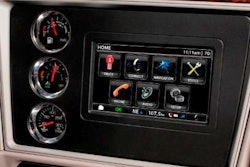ArvinMeritor exhibited its new series of Meritor ProTec High Mobility Independent Suspensions (HMIS) and All-Wheel Drive (AWD) Systems to support customer demands for superior protection, mobility, ride quality and reliability at the recent U.S. Army (AUSA) Annual Meeting and Exhibition.
Designed for tactical wheeled military vehicles and armored personnel carriers, as well as specialty and off-highway applications in extreme combat environments, the Meritor ProTec HMIS is available in three configurations: Series 30 for light duty; Series 40 for medium and medium-heavy duty; and Series 50 for heavy-duty applications. Customized configurations are available for demanding requirements.
“The military demands components designed for uncompromised quality, durability and performance,” says David Damian, director of sales and business development, Defense, ArvinMeritor. “As a result of the extreme challenges faced on a daily basis by the war fighter, we have engineered the Meritor ProTec high-mobility independent suspensions to provide optimized levels of protection, maximum payload and reliable performance.”
ArvinMeritor says features of the ProTec HMIS Series, designed to deliver both weight savings and durability, include:
• Interchangeable use of air springs, air struts, coil springs and hydrostruts;
• Up to 38-degree turn angle, delivering maximum maneuverability;
• Up to 21 inches of total wheel travel, providing maximum offroad mobility;
• Optional limited slip differential, no-spin differential and driver-controlled differential lock to enhance performance; and
• Standard outboard mounted brakes, available in disc or drum, with air or hydraulic actuation.
Additional Meritor defense products on display include:
• Single and tandem military axles and the Meritor MX-830-10 front axle;
• Military grade transfer cases to be used in a variety of wheeled and combat vehicles and heavily armored personnel carries; and
• Meritor Xtended Lube MXL drivelines, combining universal joints and driveline components to provide longer service life, extended maintenance intervals and low lifecycle costs.










